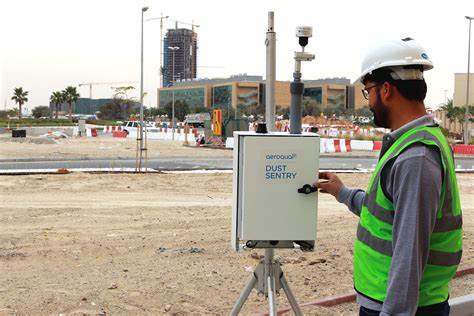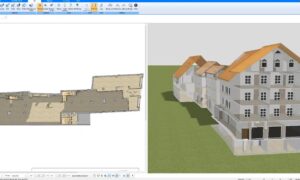The air quality is often significantly and persistently impacted by construction developments, roads, and other infrastructure projects. There is usually an increase in dust or particulate matter (PM) concentrations among the impacts.
Depending on the level of risk, demolition and construction activities may require monitoring to lessen the potential for environmental damage.
Regarding construction sites, it is recommended that priority be assigned to the measurement of PM10, as dust emissions from construction sites are predominantly in the coarser fractions.
Still, the monitoring of PM2.5 and/or TSP concentrations can be useful in identifying source contributions.
Our health and well-being depend on clean air, and poor air quality can harm everyone and everything around us.
Workplace air quality monitoring is essential because contaminants like dust can cause serious health problems for employees.
Is it Good to Always Check the Air Quality?
- A proactive approach to air quality monitoring improves the health and safety of workers by lowering the chance of injuries and illnesses occurring. A safe workplace is a legal requirement; this tool will help you meet that standard.
- Workers are less likely to be exposed to harmful chemicals, lowering the risk of cancer and other respiratory illnesses.
- Achieving regulatory compliance: Proactive monitoring can not only assist in improving your safety record but will also help guarantee that you are following local legislation of worker protection from toxic substances in the workplace (such as Occupational Safety and Health Administration (OSHA)).
Checking the air quality in a working place is always a good idea so that employees and the environment can remain dust-free and healthy.
Benefits of Air Quality Monitoring
The data is in real-time:
The outcomes of your efforts can be tracked in real-time with automated air quality monitoring. For instance, you can monitor the amount of dust or CO2 captured. Check for potential difficulties with your machinery before they become major problems with this method.
Automatic warnings:
Without having to keep an eye on the app or manually check in once every day or two, you can still be notified when something requires your attention, thanks to the automated notifications option (or more often). Whenever one of your machines breaks down or isn’t performing as it should, you’ll be notified immediately, preventing any further harm until maintenance can be performed.
No handwork is required:
Some may worry that this will make their work more difficult because they will be left with nothing to do after everything is automated. Still, our research has shown that most individuals prefer having more leisure time.
Why is it Beneficial to Always Check the Quality of the Air When Constructing?
There are a variety of advantages to routinely monitoring the air quality on construction sites.
- Saving money- Proactive monitoring can save money on OSHA and EPA fines by minimising the frequency with which emergency testing and investigations must be conducted.
- Air quality has greatly improved- You can act promptly by monitoring things before they become problems for employees or customers (and become too costly to fix).
- Improvements in meeting regulatory requirements, such as OSHA’s Permissible Exposure Limit (PEL) standards or EPA’s National Ambient Air Quality Standards (NAAQS).
What Kinds of Tools for Checking the Air Quality are Often Used When Constructing?
Monitoring Air Quality at Construction sites can be beneficial. And A variety of Equipment is available to quality; Some instances are as follows:
Dust, soot, and pollen are some examples of solid particles that can be detected by particulate matter sensors, which analyse the levels of these and other airborne contaminants.
These sensors are frequently employed in the construction industry to gauge the concentration of dust and waste produced by processes like sandblasting and welding.
Carbon dioxide sensors monitor carbon dioxide levels in enclosed environments where people may risk carbon monoxide poisoning, such as offices and factories (e.g., faulty boilers).
Hydrogen sulphide (H2S) gas, which has the unpleasant odour of rotten eggs; methane, which has the same odour as natural gas but is much more explosive than regular methane; and propane, which has no odour but is extremely flammable when mixed with oxygen at high temperatures, are all gases that can be detected by gas detectors and are potentially dangerous in high concentrations.
What Difficulties Are Included in Establishing Proactive Air Quality Monitoring?
Many obstacles must be overcome before proactive air quality monitoring may be used in the building industry. One is the expense, which can add up quickly depending on how many different sensors are employed.
Each sensor type also has its own unique set of technical specifications that must be met before purchasing. Some varieties need electricity while others do not; some have greater ranges than others; some must be calibrated before they can offer reliable readings, and so on (and so on).
Aside from these factors, your company or project team may also need to consider how and where data will be saved and who will oversee the data collection and storage process.
Conclusion
Proactive air quality monitoring is a crucial mechanism for protecting the well-being of construction workers. Companies in the construction industry can decrease health hazards and ensure regulatory compliance by continuously monitoring air quality levels and delivering real-time data and automated alarms.
Proactive air quality monitoring is a good investment for any construction company since it improves safety, lowers costs, and increases compliance, even though it may come with certain problems. There is a direct correlation between a company’s dedication to its employees’ well-being and financial line and its standing in the marketplace.



































